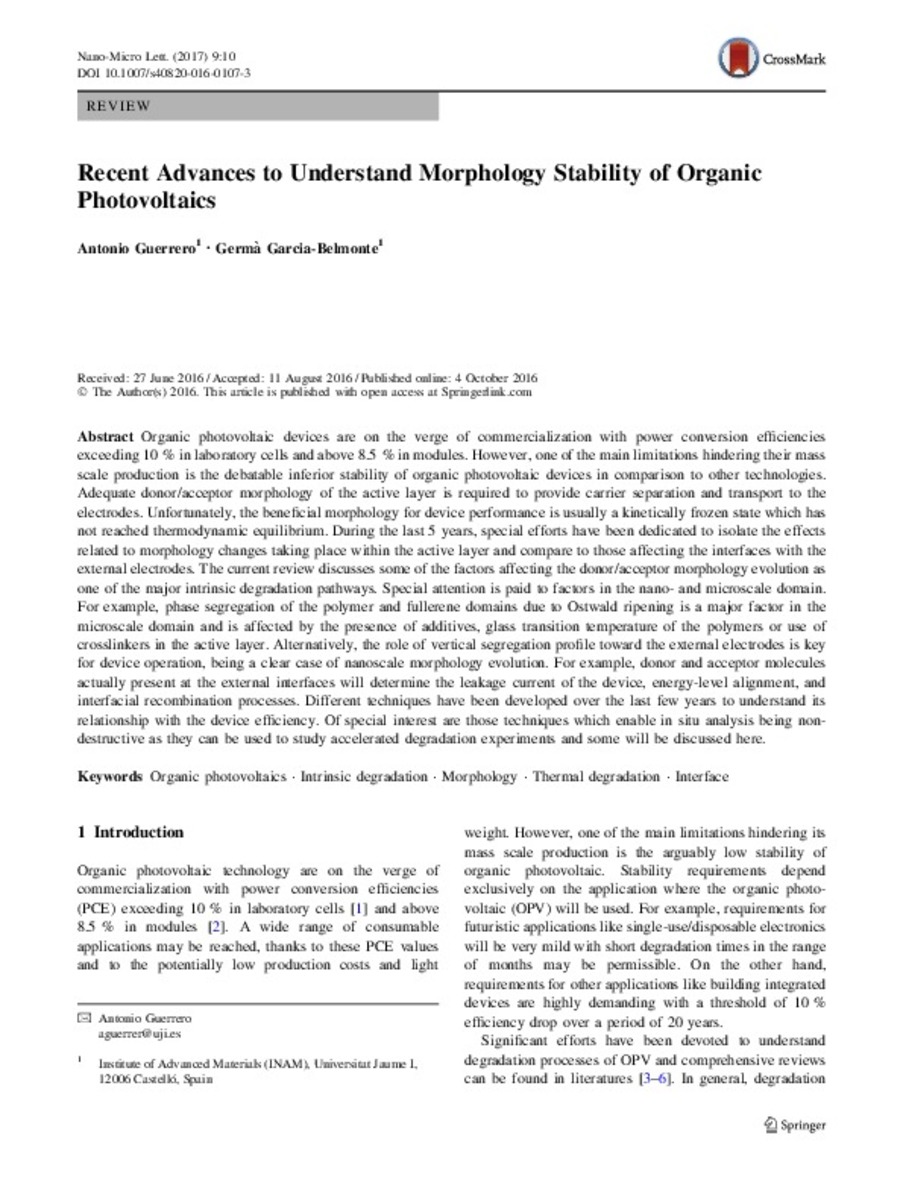Mostrar el registro sencillo del ítem
Recent advances to understand morphology stability of organic photovoltaics
| dc.contributor.author | Guerrero, Antonio | |
| dc.contributor.author | Garcia-Belmonte, Germà | |
| dc.date.accessioned | 2017-03-22T11:22:28Z | |
| dc.date.available | 2017-03-22T11:22:28Z | |
| dc.date.issued | 2017 | |
| dc.identifier.citation | Guerrero, A. & Garcia-Belmonte, G. Nano-Micro Lett. (2017) 9: 10. doi:10.1007/s40820-016-0107-3 | ca_CA |
| dc.identifier.issn | 2311-6706 | |
| dc.identifier.issn | 2150-5551 | |
| dc.identifier.uri | http://hdl.handle.net/10234/166915 | |
| dc.description.abstract | Organic photovoltaic devices are on the verge of commercialization with power conversion efficiencies exceeding 10 % in laboratory cells and above 8.5 % in modules. However, one of the main limitations hindering their mass scale production is the debatable inferior stability of organic photovoltaic devices in comparison to other technologies. Adequate donor/acceptor morphology of the active layer is required to provide carrier separation and transport to the electrodes. Unfortunately, the beneficial morphology for device performance is usually a kinetically frozen state which has not reached thermodynamic equilibrium. During the last 5 years, special efforts have been dedicated to isolate the effects related to morphology changes taking place within the active layer and compare to those affecting the interfaces with the external electrodes. The current review discusses some of the factors affecting the donor/acceptor morphology evolution as one of the major intrinsic degradation pathways. Special attention is paid to factors in the nano- and microscale domain. For example, phase segregation of the polymer and fullerene domains due to Ostwald ripening is a major factor in the microscale domain and is affected by the presence of additives, glass transition temperature of the polymers or use of crosslinkers in the active layer. Alternatively, the role of vertical segregation profile toward the external electrodes is key for device operation, being a clear case of nanoscale morphology evolution. For example, donor and acceptor molecules actually present at the external interfaces will determine the leakage current of the device, energy-level alignment, and interfacial recombination processes. Different techniques have been developed over the last few years to understand its relationship with the device efficiency. Of special interest are those techniques which enable in situ analysis being nondestructive as they can be used to study accelerated degradation experiments and some will be discussed here. | ca_CA |
| dc.description.sponsorShip | This work was partially supported by FP7 European collaborative project SUNFLOWER (FP7-ICT-2011-7- contract No. 287594), the Spanish Ministerio de Economı´a y Competitividad (project MAT2013-47192-C3-1-R), and Generalitat Valenciana (project ISIC/2012/008 Institute of Nanotechnologies for Clean Energies). A.G. would like to thank the Spanish Ministerio de Economı´a y Competitividad for a Ramo´n y Cajal Fellowship (RYC- 2014-16809). | ca_CA |
| dc.format.extent | 16 p. | ca_CA |
| dc.format.mimetype | application/pdf | ca_CA |
| dc.language.iso | eng | ca_CA |
| dc.publisher | SpringerOpen | ca_CA |
| dc.relation.isPartOf | Nano-Micro Lett. (2017) 9:10 | ca_CA |
| dc.rights | This article is distributed under the terms of the Creative Commons Attribution 4.0 International License (http://crea tivecommons.org/licenses/by/4.0/), which permits unrestricted use, distribution, and reproduction in any medium, provided you give appropriate credit to the original author(s) and the source, provide a link to the Creative Commons license, and indicate if changes were made. | ca_CA |
| dc.rights | Atribución 4.0 España | * |
| dc.rights.uri | http://creativecommons.org/licenses/by-sa/4.0/ | * |
| dc.subject | Organic photovoltaics | ca_CA |
| dc.subject | Intrinsic degradation | ca_CA |
| dc.subject | Morphology | ca_CA |
| dc.subject | Thermal degradation | ca_CA |
| dc.subject | Interface | ca_CA |
| dc.title | Recent advances to understand morphology stability of organic photovoltaics | ca_CA |
| dc.type | info:eu-repo/semantics/article | ca_CA |
| dc.identifier.doi | http://dx.doi.org/10.1007/s40820-016-0107-3 | |
| dc.rights.accessRights | info:eu-repo/semantics/openAccess | ca_CA |
| dc.relation.publisherVersion | http://www.nmletters.org/component/k2/item/454-recent-advances-to-understand-morphology-stability-of-organic-photovoltaics?Itemid=621 | ca_CA |
| dc.type.version | info:eu-repo/semantics/publishedVersion |
Ficheros en el ítem
Este ítem aparece en la(s) siguiente(s) colección(ones)
-
INAM_Articles [506]
Excepto si se señala otra cosa, la licencia del ítem se describe como: This article is distributed under the terms of the
Creative Commons Attribution 4.0 International License (http://crea
tivecommons.org/licenses/by/4.0/), which permits unrestricted use,
distribution, and reproduction in any medium, provided you give
appropriate credit to the original author(s) and the source, provide a link to the Creative Commons license, and indicate if changes were
made.








